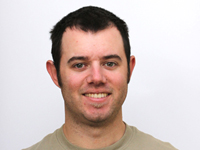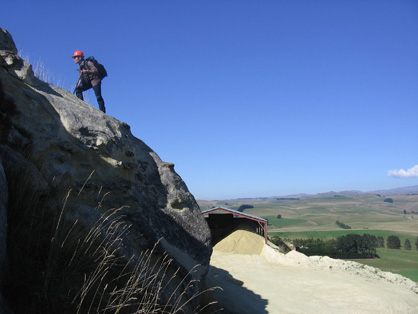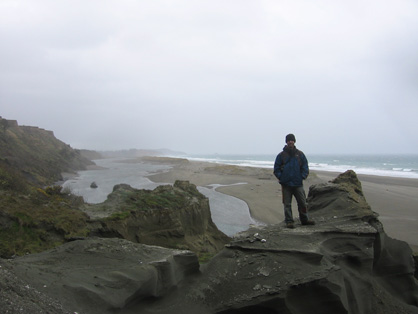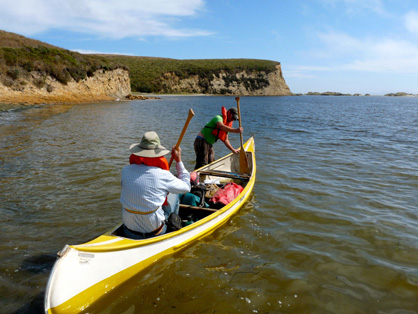 USA
USA
PhD title: Morphology, phylogeny, and function of Eomysticetidae, archaic baleen whales (Cetacea: Mysticeti) from the Oligocene of New Zealand
Research Blog:http://coastalpaleo.blogspot.co.nz/
Supervisor:Ewan Fordyce
Email: robert.boessenecker [at] otago.ac.nz
Project Summary
Baleen whales (mysticetes) are an extant group of cetaceans (whales and dolphins) and have a long and rich fossil record, and fossils of extinct baleen whales have proven invaluable for reconstructing the timing and sequence of anatomical changes leading up to modern lineages. The earliest baleen whales primitively retained teeth, and although transitional toothed mysticetes have been reported with bony correlates of baleen – providing an anatomical transition between tooth-bearing and baleen-bearing mysticetes – other changes in skull anatomy and the particular changes in feeding ecology occurring within this transition remain poorly known. The Eomysticetidae are a recently recognized group of early-diverging toothless baleen whales, thus far only reported from South Carolina, USA. Eomysticetids are relatively large (~10 meters body length) with hyper-elongate and flattened snouts, 'grooves' in the palate suggesting the presence of baleen, large areas for jaw muscle attachment, small eye sockets, and long, delicate mandibles. The extreme proportions of their feeding apparatus are distinctive in comparison to all previous and subsequent baleen whales (tooth- or baleen-bearing).
The discovery of a large volume of eomysticetid fossils, including multiple anatomically informative skulls with associated mandibles, earbones, and postcranial skeletons from the Oligocene Kokamu Greensand and Otekaike Limestone of north Otago and south Canterbury, and the reinterpretation of “Mauicetus” lophocephalus and “Mauicetus” waitakiensis (Marples, 1956) as eomysticetids suggests an unexpected diversity of these archaic mysticetes. This dissertation study proposes to 1) describe the skeletal anatomy of these new eomysticetid taxa in order to further clarify our anatomical knowledge of the family, 2) carefully redescribe fossils of “Mauicetus” originally named by Marples; 3) place these taxa within a phylogenetic context and test hypotheses of eomysticetid monophyly (or alternatively, paraphyly), and 4) investigate the possible implications of the eomysticetid “archetype” for the evolution of the feeding apparatus in early baleen whales.

Fellow Ph.D. student Cheng-Hsiu Tsai prospecting for fossil cetaceans in the Otekaike Limestone in North Otago, March 2012.
Research Collaborations
I have a number of other studies I am currently collaborating on with other colleagues. Several of these are with colleague Morgan Churchill (University of Wyoming, USA) regarding the fossil record and phylogeny of pinnipeds: two studies are nearing completion, focused on description of new fossil material of the rare walrus Pelagiarctos and reevaluating previous interpretations of its ecology as a “Killer walrus”, and a combined phylogenetic analysis of the Otariidae (fur seals and sea lions) based on a combination of molecular data and a new, large morphological data set.
Description of newly collected and anatomically informative crania, earbones, and mandibles of the bizarre dwarf baleen whale Herpetocetus bramblei and a two new species of Herpetocetus from the late Neogene of California (Purisima and San Diego Formations) involves collaborative study with Jonathan Geisler (NYCOM, Anatomy Dept., USA) and Joe El Adli (San Diego Natural History Museum, USA). These studies are concerned with the morphology, feeding ecology, ontogeny, and phylogenetic relationships of these strange cetaceans.
The preservation of modern and fossil vertebrates within the marine environment is poorly understood, and collaboration with Laura Vietti (University of Minnesota, USA) and Nick Higgs (University of Leeds, UK) is arranged for assembling a comprehensive review and perspective on processes affecting vertebrate skeletons in the marine realm. Higg's and Vietti's actualistic taphonomic backgrounds will greatly complement my “historical” perspective.
Fossil birds have a surprisingly extensive Neogene fossil record in marine strata, and ongoing collaboration with N. Adam Smith (NESCENT, North Carolina, USA) will attempt to describe and analyze the avifauna of various marine formations in Northern California. This resulted in one publication (Boessenecker and Smith, 2011) documenting a geologically young bony toothed bird from California.

Robert W. Boessenecker prospecting for fossil sea lions in the Pleistocene Port Orford Formation of southwestern Oregon, March 2009
Previous research and the Purisima Formation vertebrate assemblage
Owing to a field-based study in 2005-2006 of a newly discovered fossil vertebrate locality in the Pliocene Purisima Formation of Northern California, early on my research interests became focused on fossil marine mammals. Extensive paleontological field work in the Purisima Formation added a large volume of vertebrate fossils (sharks, bony fish, birds, pinnipeds, and cetaceans), and a long term research goal is to publish and describe many of these new finds, including new species of pinnipeds and cetaceans. Several published studies have resulted from this so far, papers describing a pilot whale-like odontocete and an entire marine mammal fossil assemblage are currently underway.
Because the Purisima Formation preserves fossil vertebrates in a number of depositional settings (offshore, transitional zone, shoreface), it offers a unique opportunity to study onshore-offshore changes in vertebrate preservation. Previous studies of marine vertebrate taphonomy have focused on individual skeletons, localities, or formations, and thus far have not attempted to examine onshore-offshore trends. My master's thesis focused on the comparative taphonomy of these marine vertebrate assemblages, and documented onshore-offshore changes in preservation and a strong link between preservation and sequence architecture, indicating a strong relationship between fossil preservation and physical depositional processes.

Robert W. Boessenecker and Richard Hilton (Sierra College, Rocklin, California) collecting fossil cetaceans and walruses during a canoe expedition in Northern California; a 200 lb sandstone block containing a complete walrus skull was successfully removed from a remote area with the use of a canoe and cargo net. September, 2011.
Publications
Boessenecker, R.W., Perry, F.A., and Schmitt, J.G. 2014. Comparative taphonomy, taphofacies, and bonebeds of the Mio-Pliocene Purisima Formation, central California: strong physical control on marine vertebrate preservation in shallow marine settings. PLOS One 9:3:e91419. doi: 10.1371/journal.pone.0091419
- Racicot, R.A., Demere, T.A., Beatty, B.L., and R.W. Boessenecker. 2014. Unique feeding morphology in a new prognathous extinct porpoise from the Pliocene of California. Current Biology 24:1-6. doi: 10.1016/j.cub.2014.02.031
- El Adli, J., Deméré, T.A., and Boessenecker, R.W. In press. A new species of the diminutive baleen whale Herpetocetus (Cetacea: Mysticeti) from the upper Pliocene (Piacenzian) of California, USA with observations on the evolution and relationships of the Cetotheriidae. Zoological Journal of the Linnean Society.
- Boessenecker, R.W. 2013. A new marine vertebrate assemblage from the Late Neogene Purisima Formation in Central California, Part II: Pinnipeds and Cetaceans. Geodiversitas 35:4:815-940. doi:10.5252/g2013n4a5
- Boessenecker, R.W. 2013. Pleistocene survival of an archaic dwarf baleen whale (Mysticeti: Cetotheriidae). Naturwissenschaften 100:4:365-371. doi:10.1007/s00114-013-1037-2
- Boessenecker, R. W. 2013. Taphonomic Implications of barnacle encrusted sea lion bones from the Middle Pleistocene Port Orford Formation, coastal Oregon. Journal of Paleontology: 87, No. 4, pp. 657-663. doi:10.1666/13-005
- Boessenecker, R.W. and M. Churchill. 2013. A reevaluation of the morphology, paleoecology, and phylogenetic relationships of the enigmatic walrus Pelagiarctos. PLoS One 8(1) e54311. doi:10.1371/journal.pone.0054311
- Boessenecker, R.W., Geisler, J.H., and Perry, F.A. 2013. Globicephaline whales from the Mio-Pliocene Purisima Formation of central California. Acta Palaeontologica Polonica doi:10.4202/app.2013.0019
- Marx, F.G., Buono, M.R., Fordyce, R.E., and R.W. Boessenecker. 2013. Juvenile morphology: a clue to the origins of the most mysterious of mysticetes? Naturwissenschaften 100:3:257-261. doi:10.1007/s00114-013-1012-y
- Boessenecker, R.W. 2011A. Herpetocetine (Cetacea:Mysticeti) dentaries from the Upper Miocene Santa Margarita Sandstone of Central California. PaleoBios 30:1:1-12. Herpetocetine publication link (Berkeley)
- Boessenecker, R.W. 2011B. New records of the fur seal Callorhinus (Carnivora: Otariidae) from the Plio-Pleistocene Rio Dell Formation of Northern California and comments on otariid dental evolution. Journal of Vertebrate Paleontology 31(2):454-467. doi:10.1080/02724634.2011.550362
- Boessenecker, R.W. 2011C. A new marine vertebrate assemblage from the Purisima Formation in Central California, Part 1: fossil sharks, bony fish, birds, and implications for the age of the Neogene Purisima Formation west of the San Gregorio fault. PalArch's Journal of Vertebrate Paleontology 8(4):1-30. Purisima publication (Palarch)
- Boessenecker, R.W. and F.A. Perry. 2011. Mammalian bite marks on juvenile fur seal bones from the late Neogene Purisima Formation of Central California. Palaios 26(2):115-120. doi:10.2110/palo.2010.p10-088r
- Boessenecker, R.W. and N.A. Smith. 2011. Latest Pacific basin record of a bony-toothed bird (Aves, Pelagornithidae) from the Pliocene Purisima Formation of California, U.S.A. Journal of Vertebrate Paleontology 31(3):652-657. doi:10.1080/02724634.2011.562268
Conference Presentations
- Churchill, M.M., Boessenecker, R.W., and M.T. Clementz. 2011. Biogeographic implications of Otariidae (Mammalia: Carnivora) systematics. Journal of Vertebrate Paleontology 31:89A.
- El Adli, J., and R.W. Boessenecker. 2011. The musculature of the temporomandibular region in the Mio-Pliocene baleen [whale] genus Herpetocetus and its inference for feeding strategy. Journal of Vertebrate Paleontology 31:104A.
- Geisler, J., Martinez, M., Lambert, O., and R.W. Boessenecker. 2011. Evolution of high-frequency hearing in odontocetes (Mammalia: Cetacea). Journal of Vertebrate Paleontology 31:115A.
- Boessenecker, R.W. 2011. Marine vertebrate taphofacies of the Neogene Purisima Formation of central California: implications for the study of fossil marine vertebrates and their depositional context. Sixth Triennial Conference on Secondary Adaptation of Tetrapods to Life in Water Program with Abstracts: 12.
- Churchill, M.M., Boessenecker, R.W., and M.T. Clementz. 2011. Conservation implications of a new phylogeny of fur seals and sea lions. Annual meeting of the Society for Marine Mammals.
- Churchill, M.M., Boessenecker, R.W., and M.T. Clementz. 2011. The systematics of Otariidae, and the influence of allometry and polymorphism on morphology based phylogenetics. Sixth Triennial Conference on Secondary Adaptation of Tetrapods to Life in Water Program with Abstracts: 17.
- El Adli, J., Boessenecker, R.W., and J. H. Geisler. 2011. Taxonomic problems of and relationships among species of the fossil baleen whale genus Herpetocetus. Sixth Triennial Conference on Secondary Adaptation of Tetrapods to Life in Water Program with Abstracts: 23.
- Churchill, M. M., Boessenecker, R.W., and M. T. Clementz. 2010. Preliminary results of a comprehensive morphological phylogeny of the Pinnipedia (Mammalia: Carnivora). Journal of Vertebrate Paleontology 30:72A.
- Boessenecker, R.W. 2010. Barnacle colonization of Middle Pleistocene Sea Lion (Carnivora:Pinnipedia) bones elucidate the biostratinomy of a fossil marine mammal. Journal of Vertebrate Paleontology 30:61A.
- Haasl, D.M., L.H. Fisk, F.A. Perry, R.W. Boessenecker, S.J. Blakely, and L. R. Pratt. 2009. Paleontological resource mitigation at Santa Cruz, California. Geological Society of America Abstracts with Programs.
- Boessenecker, R.W., J.H. Geisler, and F.A. Perry. 2009.A fossil pilot whale, Globicephala sp. (Cetacea: Delphinidae) from the Late Pliocene Purisima Formation of Central California. Journal of Vertebrate Paleontology 29(3):66A.
- Boessenecker, R.W., and J. H. Geisler. 2008. New material of the bizarre whale Herpetocetus bramblei from the latest Miocene Purisima Formation of Central California. Journal of Vertebrate Paleontology 28(3):54A.
- Boessenecker, R.W.2007. New records of fur seals and walruses (Carnivora: Pinnipedia) from the late Neogene of Northern California. Journal of Vertebrate Paleontology 27(3):50A.
- Boessenecker, R.W.2006. A new marine vertebrate assemblage from the late Neogene Purisima Formation at Pomponio State Beach, California. Journal of Vertebrate Paleontology 26(3):43A.